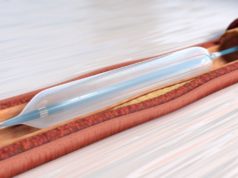
A sirolimus-eluting balloon has been shown to be effective and safe for the treatment of vasculogenic erectile dysfunction (ED) in a first-in-man study presented at the PCR e-Course 2020 (25–27 June). Giuseppe Sangiorgi (Clinica San Gaudienzio, Novara, Italy) outlined the findings from the SUASION (Sirolimus-eluting balloon utilisation for treatment of vasculogenic erectile dysfunction) study.
He said: “Interventional treatment with a sirolimus-eluting balloon may be considered as a strategic approach to patients affected by vasculogenic erectile dysfunction who are non-responding to current first-line oral phosphodiesterase-5 inhibitors.”
More than 300 million men worldwide have ED, with 52% of men in Europe between the ages of 40 and 70 years reporting some degree of ED. For patients with coronary artery disease and/or diabetes, this increases to 67%, Sangiorgi explained, adding that successful treatment has a strong impact on quality of life.
SUASION is a prospective, postmarket, non-randomised, all-comers, multicentre, single-arm study of a new sirolimus drug-eluting balloon (Magic Touch, Concept Medical) that recently received CE mark, and, said Sangiorgi, that “is dedicated to this indication”. Patients were those affected by ED who had not responded to phosphodiesterase-5 inhibitors (PDEF-5i) for at least one year, and who presented with an international index of erectile function-5 (IEF-5) score ≤12, and a dynamic Doppler with Caverjet injection with peak systolic velocity (PSV) ≤20cm/second.
The efficacy endpoint in the trial is a composite of Delta International Index of IEF-5 ≥5 and Delta Doppler PSV velocity >5cm/second, at six-month follow-up. The safety endpoint is freedom from target lesion revascularisation (TLR) at eight-month follow-up.
Sangiorgi said: “So far, we have enrolled 27 patients, with a mean age of 60 years, and we should reach the target number of 100 patients by the end of the year. This is a very common population that we treat in our cath labs—diabetes mellitus in approximately 30%, and 30% of patients presented with coronary artery disease, and are undergoing therapy for it. The baseline IIEF score was 9.7±6.6 [which is] moderate to severe erectile dysfunction.”
The target lesion was the internal pudendal artery in 90% of patients. Bilateral disease affected 26%. In a minority of cases (14%), a drug-eluting stent was required, due, said Sangiorgi, to “a residual stenosis of less than 30%, or a flow limiting dissection”. Procedural success was 100%.
Treatment success was measured by the minimum clinically relevant improvement in the IIEF-5 score and in Dynamic Doppler PSV between baseline and six-month follow-up. Sangiorgi reported that more than 74% had an improvement of >5 in the IIEF-5 score, and 73% had a Doppler PSV score increase of >10. At six months, this was 70.4% and 68.4%, respectively.
Summarising, he said: “Erectile dysfunction shares modifiable major cardiovascular risk factors with coronary artery disease and peripheral artery disease. The vast majority of patients with erectile dysfunction presented with an arterial stenosis affecting the iliac-pudendal-penile arteries. Of the 27 patients who reached six-month follow-up, 69% had improved their IEF-5 score and Doppler PSV compared to baseline. Percutaneous treatment with a sirolimus-eluting balloon may become the second line of therapy for patients with erectile dysfunction.”
Analysing the findings for Vascular News, Sangiorgi said: “It is of paramount importance to create acknowledgment between urologists, andrologists and, above all, cardiologists that ED may represent the ‘tip of the iceberg’ of coronary atherosclerotic disease, and that mechanical revascularisation of the pudendal district has the potential to improve the quality of life of patients affected by vasculogenic erectile dysfunction. In Italy, the Italian Society of Urology (SIU), the Italian Society of Andrologists (SIA), and the Italian Society of Interventional Cardiology (GISE) are actively working on a consensus document to add this type of treatment as a second-line therapy in selective patients after a pharmacologic approach has failed.”













